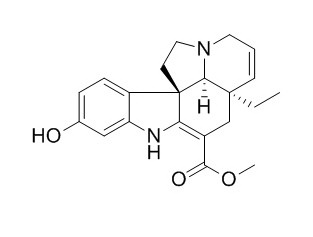11-Hydroxytabersonine
11-Hydroxytabersonine has antitumor activety.
Inquire / Order:
manager@chemfaces.com
Technical Inquiries:
service@chemfaces.com
Tel:
+86-27-84237783
Fax:
+86-27-84254680
Address:
1 Building, No. 83, CheCheng Rd., Wuhan Economic and Technological Development Zone, Wuhan, Hubei 430056, PRC
Providing storage is as stated on the product vial and the vial is kept tightly sealed, the product can be stored for up to
24 months(2-8C).
Wherever possible, you should prepare and use solutions on the same day. However, if you need to make up stock solutions in advance, we recommend that you store the solution as aliquots in tightly sealed vials at -20C. Generally, these will be useable for up to two weeks. Before use, and prior to opening the vial we recommend that you allow your product to equilibrate to room temperature for at least 1 hour.
Need more advice on solubility, usage and handling? Please email to: service@chemfaces.com
The packaging of the product may have turned upside down during transportation, resulting in the natural compounds adhering to the neck or cap of the vial. take the vial out of its packaging and gently shake to let the compounds fall to the bottom of the vial. for liquid products, centrifuge at 200-500 RPM to gather the liquid at the bottom of the vial. try to avoid loss or contamination during handling.
Nutrients.2020, 12(12):3638.
Korean J. Medicinal Crop Sci2021, 10:345-352.
Sustainability2021, 13(23),12981.
Molecules.2017, 22(2)
PLoS One.2018, 13(3):e0193386
BMC Complement Altern Med.2014, 14:352
Fitoterapia.2024, 175:105955.
Antioxidants (Basel).2020, 9(6):544.
Int Immunopharmacol.2024, 141:112906.
J of Food Quality2020, 8851285.
Related and Featured Products
Chinese Traditional & Herbal Drugs,1998,29(12):793-5.
Studies on the Chemical Constituents of Hemsley Melodinus (Melodinus hemsleyanus)[Reference:
WebLink]
METHODS AND RESULTS:
10 compounds were isolated from Melodinus hemsleyanus Diels. and their structures were determined by spectral analysis and chemical reactions. They were 11-Hydroxytabersonine (Ⅰ), scandine (Ⅱ), 10-hydroxyscandine(Ⅲ), tubotaiwine(Ⅳ), tubotaiwine N-oxide(Ⅴ), 15α-hydroxykopsinine(Ⅵ),vincoline(Ⅶ), 19R-vindolinine N-oxide(Ⅷ), 16 β-hydroxy-19R-vindolinine (Ⅸ) and a new compound, 16β-hydroxy-19S-vindoline N-oxide(Ⅹ).
CONCLUSIONS:
Pharmacological screening revealed that Ⅰ had antitumor activety.
Zhongguo Zhong Yao Za Zhi. 2013 May;38(10):1548-51.
Chemical constituents from twigs and leaves of Melodinus hemsleyanus.[Pubmed:
23947135]
To study the chemical constituents in the twigs and leaves of Melodinus hemsleyanus.
METHODS AND RESULTS:
The chemical constituents were isolated by silica gel, ODS and Sephadex LH-20 column chromatographies. Their structures were determined by chemical and spectroscopic methods. Fourteen compounds were isolated from the 95% ethanol extract of the twigs and leaves of M. hemsleyanus. Their structures were identified as 11-Hydroxytabersonine (1), venalstonid (2), sandine (3), oleanolic acid (4), ursolic acid (5), betulin (6), (+)-pinoresinol (7), (-)-syringaresinol (8), 8-hydroxypinoresinol (9), (-)-latifolin (10), cirsilineol (11), loganin (12), dibutylterephthalate (13), and beta-sitosterol (14).
CONCLUSIONS:
Compounds 4-14 were obtained from this plant for the first time.
Planta Med. 1988 Aug;54(4):315-7.
Study on the Alkaloids of Melodinus tenuicaudatus.[Pubmed:
17265274]
METHODS AND RESULTS:
Fourteen alkaloids were isolated from the stem bark of MELODINUS TENUICAUDATUS Tsiang et P. T. Li. Eleven of them were identified as known alkaloids, namely, scandine ( 2), Delta (14)-eburnamine ( 4), vindolinine N(b)-oxide ( 5), 11-methoxytabersonine ( 6), vindolinine ( 7), EPI-vindolinine N(b)-oxide ( 8), hazuntine ( 9), compactinervine ( 10), 11-Hydroxytabersonine ( 11), Delta (14)-vincine ( 12), and normacusine B ( 14).
CONCLUSIONS:
Two alkaloids were new: 10-hydroxyscandine ( 1), and the dimer, tenuicausine ( 3); their structures were elucidated by spectroscopic and chemical methods. One alkaloid ( 13) occurring in trace amounts, could not be identified.



